Introduction
The Ashargia Chamber is one of Saudi Arabia’s oldest and well-established service organizations. Its operations are devoted to the cause of promotion of the welfare of private sectors so that they are best positioned to contribute to the economy. The chamber is dedicated to helping the private sector to optimally go about their operations. This it achieves through creating promotional fairs for traders in different industries and trades. It also has a number of developmental services that private traders can access whenever needed.
The chamber provides essential services to the business community guided by the principle of parity and equity. Its major objective has been to facilitate the growth of the economy through mobilizing of resources and supporting private sector players. Progressively, the Chamber has moved from providing extended services to only traders to include the community at large. This has been achieved in the last fifty years and has contributed immensely to business expansion in Saudi Arabia.
The human resource department has been concerned with performance and organization of procedures and works related to the human resources development in coordination with the chamber of commerce and industry of Eastern Province. The human resources department is divided into two sections; the personnel affairs and Organizations development. The researcher’s role has been centred in the recruitment unit as a supervisor and it involves taking care of all recruitment activities and processes such as managing all job vacancy requests and CVs and performing shortlisting and interview schedules. Besides this, the researcher prepares reports and presentation related material to the HR department with full awareness of all HR activities.
Asharqia chamber has signed a project contract with TATA consultancy services “TCS” to implement a new ERP system “Oracle” in 3 phases. The first phase to be commissioned is the HR and finance, which will be followed by the second i.e. e-recruitment while the third phase is about self-services.
Aim
The main aim of the project is to understand how the ERP will add value to the company business and service delivery. Because of sound management and ultimate that business accrues from incorporating new technologies, the new system adoption aims at enabling the human resource department and the finance department to have efficient management practices so that proper and well-coordinated functions can be made to contribute to elaborate decision making.
The research aims at analyzing the current system which is in place. Once the current system is analyzed, it will help in establishing gaps that the new system should address. This will lead to an analysis of the new system to see if it fits or can satisfy the established needs. The analysis will help in ascertaining the old system’s reliability, strength, accuracy and costs and how it impacts the company. The project further aims at establishing how the proposed system when introduced in the company will affect the company operations and output. The new system’s impact on company output will be established through the identification or determination of likely performance of the new system once it is instituted in terms of reliability, cost-effectiveness, security, timely production of reports, and providing the management with the required information in time to facilitate decision making.
Objectives
The project has a number of objectives that evolve around the proposed system. The new system is expected to meet the company’s goals of achieving better managerial responsibilities in diverse platforms within and across its business boundaries. The project’s main objective is to forecast how beneficial the new system will be. The expectation is that the new system should enhance the company efficiency. To achieve the stated objective, the project will explore ways of ensuring the system implementers involve and have full support from the management board.
The current system
The company has been using the old system for a long time now. This system has been proved to be ineffective because of the changing nature of both organizational and external environment characteristics. Further, changes in technology that are shaping businesses across the world dictate that organizations adopt the new technologies for efficiency and effectiveness in the market place. E-commerce is the new big mode of business and organizations that are not adapting to re-operations are likely to be faced out.
The current system, in use at Ashargia, experiences shortfalls because it does not cover all major aspects of the company’s e-needs. The old system is not reliable in providing accurate information. If information output is not reliable it means decision making is largely affected. One other problem associated with the old system is that it is not web-based. Given it is not web-based; it does not provide the company with a reliable management facility.
The proposed system
The introduction of the new system is seen as the organization’s management as a way of redefining the delivery of services in regard to the company’s objectives and goals. Once the new system is commissioned, it is anticipated to minimize costs and time; this is in relation to the costs of employing more staff and the system operations. The new system is anticipated to provide accurate reports in a secure environment and enhance safe management practices within and across the company platform with high level of professionalism. In addition, the new system is anticipated to shape the way the human resource departments executes its operations.
Literature Review
ERP is an Industry term which outlines a broad set of activities that helps to shape and redefine businesses in the management of vital parts of its core business. The Structure and the information that is accrued from an ERP system facilitate key performance required for attaining business corporate goals. The ERP which means Enterprise Resource Planning is where businesses are integrated with modern technology and business management practices.
The integration of business processes with new information technology is critical towards success in the world of today. This integration has been transforming businesses to operate in modern information age discarding the traditional way of conducting business or managing organizational resources. This has been important to many organizations because it has enhanced service delivery to bother internal and external customers. With a touch of new technology, business processes have been made faster, easier thus improving organizational output.
The ERP system is composed of three aspects; the information technology, specific business goals and business management practices. Due to its capability, the ERP is designed to provide much needed facility to geographically dispersed businesses across a multi platform with its functional units. This functionality of the ERP system is important and advantageous as it supports management executives who are always on the move or who are not stationary to have much needed details to support their decision making wherever they may be.
ERP architecture has evolved overtime to enhance a variety of services housed in its individual unit programs. The different functional units of an ERP system have elaborate database and are interlinked as to work in unison under a single umbrella. For utmost output to accrue, the ERP system should be integrated with a facility which allows for flexibility, reliability, security and stability. Apart from the mentioned, the system should also have a global focus.
Integration is vital aspect of ERP solution, because it brings more benefits and shapes the communication and distribution of information. How the system integrates the different functions in the organization determines how well they interrelate. The efficiency and effectiveness of the interrelations between different units and departments in an organization is what leads to cost reduction and time management efficiency. When time and performance is managed properly with a concern for costs, an organization operates more optimally than otherwise. A good ERP system or solution ensures different departments or divisions in an organization are connected. Interconnectivity makes it easy to share files or to access pertinent information. This consequently increases production and performance in the business.
An ERP solution assists businesses merge their processes from all departments within the organization and consolidate it in a central database. This is achieved without incurring more costs and time hence making it easy for accessibility and smooth flow of work. Merging is achieved by building a database repository that allows integration with a variety of application software hence presenting business statistics and other information to various departments within the organization. To have an ideal ERP system, the system should have an ERP structure which is made up of integrated central database repository in a fused environment.
ERP Solutions in Finance
The market leaders or the best managed businesses in the world of today have embraced the ERP Financial Solution. The adoption of an ERP financial solution has in many cases proved to make financial management more efficient. Financial management is a cornerstone is charting organizational success. An ERP system makes financial management easier and efficient due to a number of factors.
Finance and accounting is, in a sense, about ensuring there are enough checks and controls on how organizational finances flow. ERP functions in a simple way; it has some internally embedded controls in its functions. With internal checks and controls, an ERP solution makes the preparation of accounts and other financial documents easier and fast. It is very easy to generate account statements at the end of every accounting period.
An ERP feature helps most companies to work with ease, because it can support various languages and currencies. Further, ERP systems or solutions are standardized or tailored in a way that it supports international operations; it meets the international accounting and reporting standards. Financial ERP has various features and functions that enable organization achieve its financial management standards. One of the core features of most ERP’s is the Treasury; this is a feature that helps in providing risk management ability. This facility is important because it enables an organization to know precisely how to manage their cash, and plan a head for financial risk. It also facilitates streamlining and interactions with financial institutions such as bank for matters regarding payment processes.
The treasury capability allows ERP applications to interlink endlessly with treasury activities which result in more effective control and management. It leads to integration with the ERP software general ledgers to guarantee adherent to policies and regulatory involvement in reporting financial standards. Financial chain management is a feature which is useful in ERP’s and which allows most companies to easily resolve disputes arising from invoices and significantly reduces their collections via electronic billings and other applications. Moreover, Seamless merging within ERP’s allows current information and accuracy reporting of information.
The seamless capability of ERP helps to minimize costs whereas improving net flow of cash in organizations. The feature of financial and management capability is quite beneficial in most organizations because it provide a cornerstone of accounting. This facility allows accuracy in accounts reporting major large companies with distributed networks. The solution when integrated with general ledger enables achievement of accuracy in balances and reporting.
ERP Solutions or System Application in Human Resource
Human resource is a valuable asset in a successful business enterprise. Adoption of an ERP system ensures continuous flow of Information related to labor or an organization’s personnel. When such information is received by the HR department it facilitates evaluations. Human resource related evaluations help organizations in establishing skill and knowledge needs and well as attitude related gaps or issues that have to be addressed. The collection of such information is important for employees as it is instrumentally applied to encourage development of professionalism and improvement of working conditions within the organization.
Human resource managers handle huge loads of information. In big organizations, unless technology is adopted, it is very difficult to keep up to date data on all employees. ERP Solution is a productive management tool which comes in handy to orient and help users to remain focused on their task while focusing direct link with fellow staff. This tool links personal ability and objectives to the aspirations and goals of the company. Through the use of ERP system, it is easier to facilitate collection and storage of information in a centralized location which allows staff in the human resource departments to center their goal in other strategic planning and personnel development.
Moreover, the operative functions are assumed and tailored automatically hence relieving the department personnel of work load. ERP provides integrated solution to all the different activities and functions in the human resource department. These activities and functions of the human resource department include; the administration of payroll and manpower related, employee professional growth and development and the general administration in the organization.
Apart from providing the above mentioned services to the organization, the ERP solution provides a platform to enable decision making and analysis so that it can aid in management control reporting. Communication and especially internal communication is paramount in the day to day operations in an organization. The ERP solution has been tailored to facilitate this function. Services such as opinion polls, news and appointment letters as daily communication examples have been proved efficient for being incorporated in the solution. On management, the ERP features have tended to vary in regard of employee social benefits. but this social benefits such as vacation and trips and assessment forms have been catered in most ERP’s this simplify the work of Human resource department.
ERP Solutions in E- recruitment
ERP solutions have enabled what is referred to as e-recruitment. The development of e-recruitment practice enabled by development of supporting ERP solutions play an important role in reduction of recruitment related costs for an organization. As the world job market gets complex and more demanding, many organizations have come up with e-recruitment process to enhance tapping the correct talent within and across their borders. This means finding the right person for the right job.
Developing a worthwhile human resource pool and human resource management structures is of great necessity to organizations. It is the human resource pool that drives the organization’s strategic goals or objectives to realization. E-recruitment facilitates or plays a critical role towards identification of the right kind of employees in the globalized job market. E-recruitment assists the company to manage its recruitments processes more effectively.
Research Methodology
Research Design
This chapter presents the research design or the methodology used. It entails the way the study was designed, the target group and the data collection techniques and data analysis procedure. This was a case study and depended on primary and secondary data collected through questionnaires and direct interviews. The study was carried out to explore the new system and identify its strengths. To understand how to optimize the new system, the old system was studied to identify its weak points. Further, the study focused on how to ensure feedback about the system is continually tapped into and channeled from the targeted group.
Research Population
The research targeted a group 20 employees including departmental managers of Ashargia Company and the implementers of the system. These are the people who understand and use the systems on a daily basis. The researcher used questionnaires to collect primary data from departmental employees. Personal interviews were used to collect information from the departmental managers.
Sampling Design
There are many employees in Ashargia. The employees spread over the three levels of the organizational structure i.e. top management, middle level employees and junior employees. The sample of respondents was picked from the human resource and finance department. The researcher chose to use random sampling on the employees who were available and distributed the questionnaires. This was done at lunch to avoid disrupting of normal working hours. The questionnaire was composed of open and closed question. With closed questions, the employee was to choose the correct answer whereas in open questions, the employee was allowed to write down the answer, elaborating as much as possible.
Data Collection
This section deals with the method of collecting data and the procedure that researcher used.
Primary Data
Primary data was collected using the following methods;
Interview Meetings
The researcher held meetings with departmental managers and implementers so as to understand the justification for acquiring and implementing the new system. Minutes were taken for consideration.
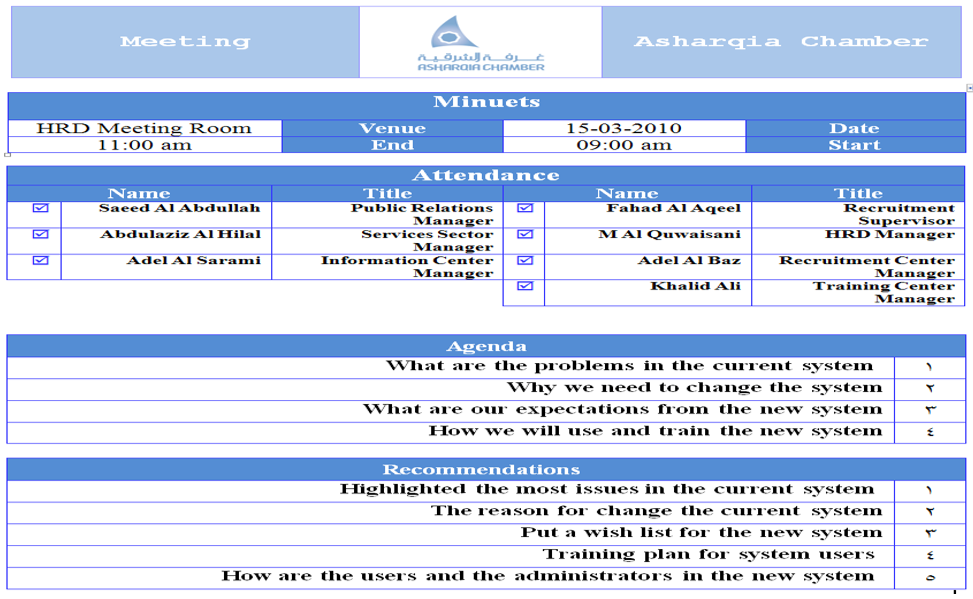
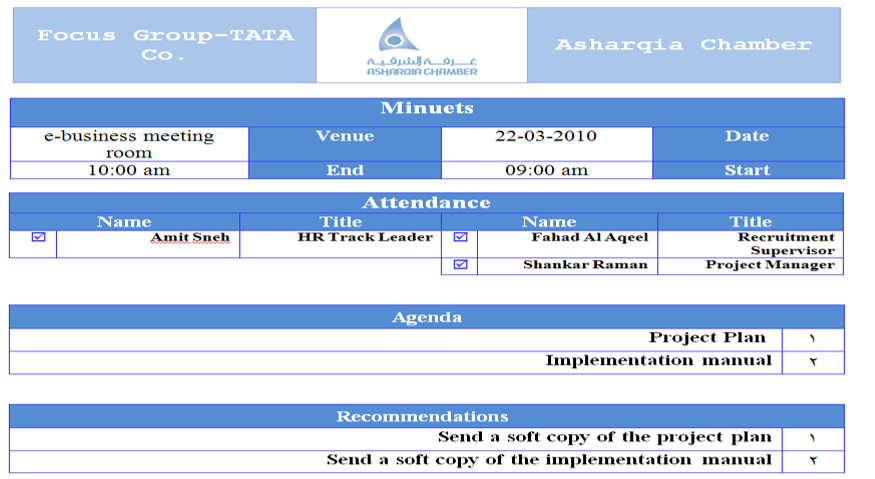
Discussion
The researcher held discussion with the system implementers to ascertain the effectiveness of the solution. The discussion notes were recorded and analyzed.
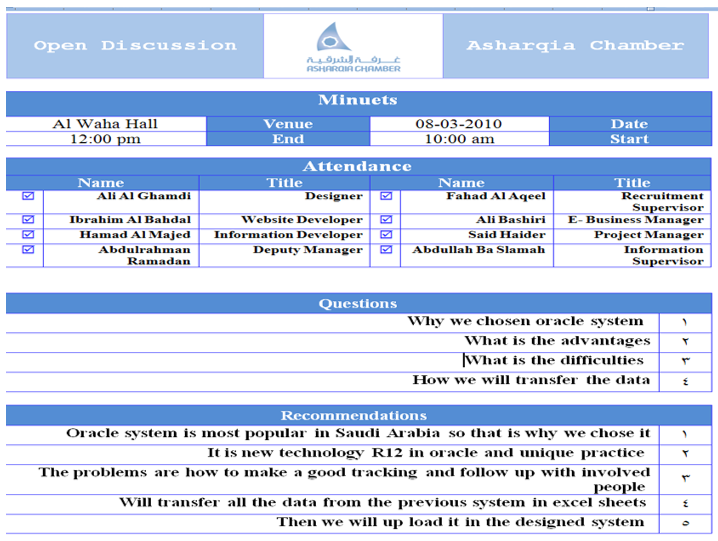
Questionnaires
Structured questionnaires comprising of 11 questions were distributed to employees and departmental heads to be filled. After filing, they were collected to assess the feedback.
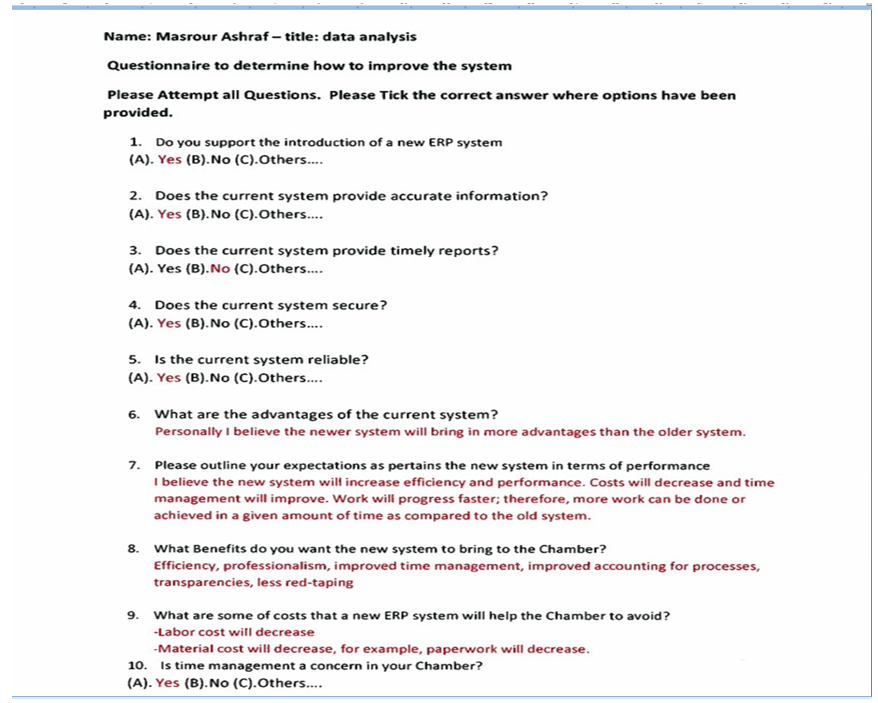
Secondary Data
Secondary data was captured using the internet, books, and implementation flow charts available from tracking team and system handout from TATA’s team in charge of implementing the project.
Web
The researcher used the internet to find more information so as to familiarize with the impact of ERP system in the human resource department. It was found out that the ERP system will be capable of handling recruitments, people management, compensation, payroll, and time management
Books
The researcher carried out extensive research in books to understand the ERP system and its corresponding impact in the human resource department.
Data Findings and Analysis
The data that was collected was largely qualitative in nature. This chapter presents the findings and implications of the findings. To understand how to improve the system so that its benefits are enhanced, respondents were asked several questions. All respondents were the employees of Asharqia. The Employees’ were given questionnaires which they filled and results analyzed. A questionnaire of 11 questions was distributed to 20 employees. They were allowed to fill and the result analyzed to determine the effectiveness and benefits expected of the new system.
Acceptance of The new system
Respondents were asked if they supported the introduction of a new system at Ashargia Chamber. Based on the answers given, 95% support the introduction of the new system. 2% indicated that they were not sure while 3% want the old system to continue being used.
The Old System’s Efficiency and Effectiveness
The respondents were asked several questions with regard to the old system. The questions were aimed at established how efficient and effective in terms of accuracy, cost and timely report generation the old system is. Figure 1.5 below shows distribution of the responses given.
The percentages in the table above indicate that the current system is not very bad. Somehow it is reliable and 75% of the employees trust it. However, a large percentage, at least 25% indicated that the system is not efficient and effective enough. To become more competitive i.e. more efficient and effective in the market place, the adoption of a new system may be very helpful.
To gauge the respondents’ appreciation of the new system, the researcher asked them to state the expected functionality and benefits to be accrued from the introduction of the new system. The respondent gave numerous benefits expected to accrue from the introduction of the new system. Figure 1.6 below shows what the employees expect the new system to be like.
From the list in figure 1.6 above, it is clear that there are enough benefits to accrue from the implementation of a new system. These expectations have to be borne in mind by the system implementers and marched with top management expectations. Once that is done, the ERP system to be implemented will be optimized to respond to the actual expectations of the respondents. For example, over 40% of the respondents indicated that they expect a user friendly interface. The system implementers have the task of ensuring the interface meets customer expectations.
The implementation process is a very important aspect of new system introduction at Arshargia. From interacting with the implementers, the researcher established that the new system is to be implemented in a ten stage process. Figure 1.7 represents the stages to be followed in implementing the new system.
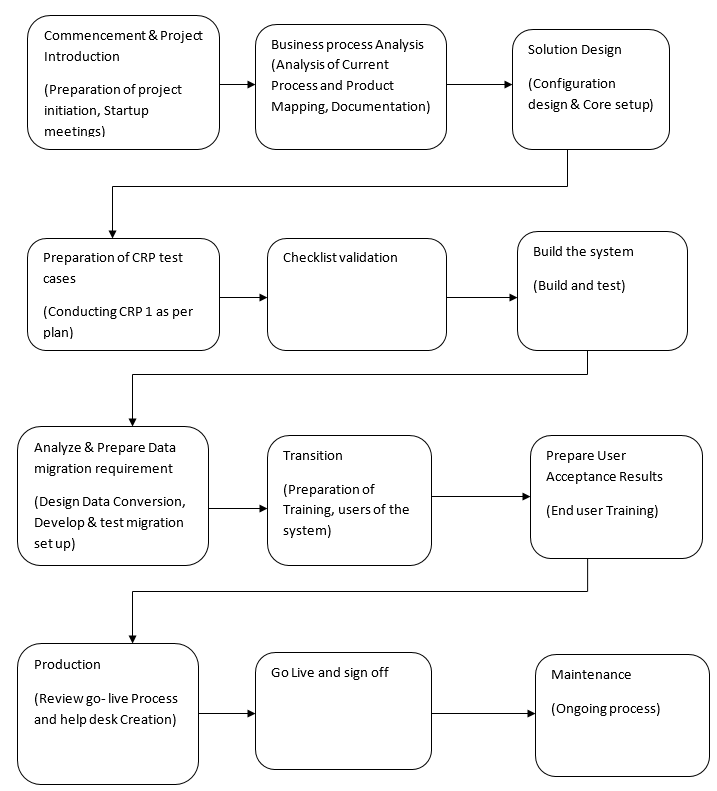
Conclusion and Recommendations
This study was about the Impact of an ERP System on the HR Department Performance in Asharqia Chamber. The broad objective of the study was to establish if the ERP System will perform best in Asharqia, how effective it is and what should be done to enhance its improvements when put in place. This research was prompted by observation that Asharqia has been having trouble with their current system or old system. The system is slow, inaccurate, it’s not secure and communication between its distributed branches is not possible. The researcher hypothesized that the current systems has slowed down the efficiency of production in the human department performance.
Research Findings
As it’s presented in chapter four, the employees of Ashargia support the introduction of a new system. The findings also indicate the implementation of a new system will facilitate efficiency and effectiveness in the Human resource department. Further, the new system will facilitate integration of operations thus enabling better flow of information in the organization. The answers to the questionnaires indicate that the new system will bring about accountability, accuracy and information security in the organization. An ERP system will not only automate the human resource department, but the entire company to facilitate service delivery and accountability in the company.
Recommendations
The research also established that some stakeholders were opposed to the implementation of the new system on the basis of it being expensive and the implementation period is long. It is therefore recommendable that the implementers of the system take time to educate all stakeholders and involve them directly. Secondly, some employees feel that the new system will not facilitate easier tracking of employees. The implementers have to debunk such fears by ensuring all employees understand how such operations can be done with ease. The system is good and as long as the implementation process is done properly, success is guaranteed.
Bibliography
Bansal, S, Technology Scorecards: Aligning IT Investments with Business Performance, John Wiley and Sons, New Jersey, NJ, 2009.
Bidgoli, H, the Internet encyclopedia, Volume 1, John Wiley and Sons, New Jersey, NJ 2004.
Chorafas, DN, Integrating ERP, CRM, supply chain management, and smart material, CRC Press, Boca Roda, FL 2001.
Cruz-Cunha, MM, Enterprise Information Systems for Business Integration in SMEs: Technological, Organizational, and Social Dimension, Idea Group Inc (IGI), New York, NY, 2009.
Godfrey, G, Enterprise Resource Planning 100 Success Secrets – 100 Most Asked Questions: The Missing ERP Software, Systems, Solutions, Applications and Implementation, Lulu.com, North Carolina, 2008.
Grant, GG, ERP & Data Warehousing in Organizations: Issues and Challenges, Group Inc (IGI), New Jersey, NJ 2003.
Kvale, S, Interviews: an Introduction to Qualitative Research Interviewing, Sage California, CA, 1996.
Leon, A, Enterprise Resource Planning, Tata McGraw-Hill, New York, 2007.
Malaga, RA, Information Systems Technology, Pearson Prentice Hall, London, 2005.
Reynolds, G, Information Technology for Managers, Cengage Learning, New York, 2009.
Srinivasan, R, International Marketing, 2nd Ed., PHI Learning Pvt. Ltd, New Delhi, 2005.
Trochim, WMK, Research Methods Knowledge Base, Atomic Dog Pub, Ohio, OH, 2001.
